| |
Organisation
The total strength of the mission has
been quoted as 140 men with 236 mounts and pack animals (see
Wehrmacht Awards Forum). This
number includes the German military cadre, the Indian nationalists, Persian tribesmen and escaped
Austro-Hungarians that later joined the expedition. After casualties, losses and desertion
there were about fifty remaining men with seventy horses and pack
animals by the time they crossed into Afghanistan.
Leadership
The expedition
was under the leadership of the Indian Nationalist Mahendra Pratap and
the German Diplomat Leutnant Werner von Hentig with a Bavarian artillery officer,
Oberleutnant Oskar Niedermayer in charge of the military aspects. This joint
leadership caused several arguments and problems between the parties
along the way. Indian Muslims were represented by Maulavi Barkatullah and the Ottoman Empire by
Captain Kâzim Orbay. When von Hentig, Pratap and Barakatullah
slept on the floor of a carriage at one point in the journey, Pratap
later wrote that there lay together "a follower of the religion of
love, a Muslim, and a militant Christian. Truly politics makes strange
bedfellows".
German Troops
The military cadre led by Niedermayer consisted of specially
chosen men, most with previous Middle Eastern or colonial experience, though the Prussian War Ministry refused permission to choose
candidates from the active officers list. They included specialists in several fields including artillery,
medicine and local languages. According to British intelligence reports
(in "Like Hidden Fire" by Peter Hopkirk) the original German
part of the mission was 84 strong, the
Phototheca-Afghanica
has the group at 27 strong. I have not yet found a rank list of this
unit.
Pathan
Volunteers
Six Afridi Pathan volunteers were recruited from "Halbmondlager", the Muslim Prisoner of War camp
near Zossen, South of Berlin.
These men were originally from the Indian North West Frontier bordering
Afghanistan. They had served in the British Indian Army and been captured on the
Western Front. They were offered the chance of freedom and to return home
if they served as armed escorts in the mission. One served as a Feldwebel
(Jemadar Mirmast),
one as a Sergeant and three as other ranks. The sixth (Seyed Achmed) was the
mission's cook and von Hentig's servant. Two Afghan Pathans, (Abdur Rahmen Khan and
Abdul Subhan Khan),
also volunteered for the mission having arrived in Germany from the
United Sates of America via Britain and Holland to fight in the Holy War
against British India.
Austro-Hungarian Prisoners of War
A number of Austro-Hungarian prisoners of war who had escaped from
Russian prison camps joined the group in Persia. I have yet to find
exact numbers for these men. At least five of them are seen in a photograph printed in Kaskett magazine.
Locally Recruited Personnel
Persian tribesmen were hired by the mission as guides along the way.
Other Mesopotamians and Persians
were recruited as mule guides, porters and servants as needed.
Along the way several deserted or were left behind and at least one was
shot while trying to defect to the enemy.
Uniforms of the Afghan Mission
| The
original military cadre of the team were kitted out in stocks of
South West African Landespolizei uniforms (see
Landespolizei Page) as well
as additional items of private purchase and local supplies.
They wore the Landespolizei Südwester hat
with small imperial cockade at the front and yellow metal imperial crown
holding up the folded right hand side. Their tunic was from the 1907 Landespolizei dark
khaki uniform but without the rank insignia or green collar and shoulder
straps. Like the Landespolizei they are seen in period
photographs wearing khaki riding breeches with brown leather gaiters and
short boots, though some men wore puttees rather than gaiters.
Their personal equipment was also from Landespolizei stock and included
the Landespolizei Sam Brown belt with eight ammunition pouches.
Any uniform appearance was however not possible during their
expedition. For the journey across the Persian desert the mission all
wore local tribal clothing for practical reasons and to disguise
themselves as much as possible.
When the mission crossed the
Afghan border they stopped to
rest and recuperate while messengers were sent to
the Emir in Kabul requesting an audience. Here the Germans
discarded their Persian clothing and proudly put their Landespolizei
uniforms back on. The Emir then sent cordial
greetings to the mission along with new clothing tailored in
Afghanistan to
replace some that had been worn out on the journey across the
Persian desert. |
|
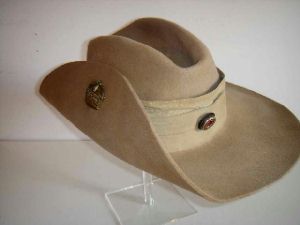
Landespolizei Südwester
Note the Imperial Crown on the right hand side and the Imperial
cockade at the front
(See
Südwester Details Page)
Photo ©
Doppler Collection |
Leutnant Werner von Hentig
retained an immaculate white Cuirassier officer's uniform for his
audience with the Emir. The Ottoman
army officer who represented the Sultan on the expedition, Major Kazim Bey wore
an Ottoman Army Officer's Uniform. The Indian nationalist leaders wore
civilian clothing (see photos below).
The Pathan former prisoners of
war that accompanied the expedition were initially given what
appears in period photographs to be East African Askari Uniforms
these were later replaced by Landespolizei uniforms as worn by
the German members of the mission and white turbans (see photos below).
A photograph in Kaskett magazine shows Austro-Hungarian
former Prisoners of War alongside Niedermayer and his
staff still wearing their pike-grey peaked caps and a variety of
Austro-Hungarian army uniforms, though they may
have been in a state of some disrepair after the men's imprisonment and
subsequent escape.
Along the way the mission also employed
Persian tribesmen to serve as guards and guides. They wore their traditional
robes and turbans, no doubt with bandoliers of ammunition.
| |
|
|
| |
The Illustrations
Figure 1- German Diplomatic Officer,
Afghan Mission,
Afghanistan
1915
This illustration is based on
a photograph of Leutnant Werner von Hentig, the leader of the
German diplomatic mission. He wears his white uniform as an officer in
the 3rd East Prussian Cuirassiers ("Kürassier-Regiment
'Graf Wrangel' (Ostpreußisches) Nr.3") which he kept packed and pristine throughout the
journey to Afghanistan. The uniform is white with light blue
piping, collar and Swedish style cuffs. The polished steel Cuirassier helmet with a yellow metal
spike and Prussian eagle was standard for his regiment. He wears privately
purchased short riding boots rather than the Cuirassier long boots and
his horse has a locally acquired blanket along with his riding saddle.
Figure 2- German Officer,
Afghan Mission, Afghanistan
1915
This illustration is based on
a photograph of Kapitänleutnant d.R
Kurt Wagner wearing
the South West
African Landespolizei 1907 Dark Khaki Uniform with Südwester hat
(note the Imperial crown badge holding up the right hand side of the
brim). He wears khaki corduroy riding breeches and field grey
puttees with marching boots. He is armed with a shotgun or hunting rifle,
possibly privately purchased and two pistols, one of which is a naval issue long pistol.
The bandolier
is also Landespolizei stock.
Figure 3- German Trooper,
Afghan Mission,
Afghanistan
1915
This illustration is based on
a photograph of Niedermayer's orderly, Hans Jakob. He wears
the 1907 Landespolizei uniform with the cuffs rolled up and the
Landespolizei Südwester hat (note the cockade
on the front). He wears khaki or dark khaki trousers rolled up. He
may be wearing locally purchased sandals but does not appear to have
German riding boots or gaiters. He carries a Gew 98 rifle and the Landespolizei ammunition bandolier. Note the two water bottles on his
saddle and the water bag below, the local blanket and the generally well laden horse equipment.
Figure 4- Pathan NCO,
Afghan Mission, Afghanistan
1915
This illustration is based on a
photograph of
Feldwebel Jemadar Mirmast,
one the Pathan volunteers on the Afghan Mission. He wears the
Landespolizei tunic which judging from the few period photographs
available, replaced their original East African Askari uniforms.
His trousers are khaki and patched, they may from his original
Askari issue. He along with other Pathans in the original photograph wears
a white turban. He appears to have no rank insignia but carries a
pistol on a lanyard. He also has the Landespolizei ammunition
bandolier, brown leather belt and carries the shoulder straps of a
small backpack.
Figure 5- Austro-Hungarian Soldier,
Afghan Mission,
Afghanistan
1915
This illustration is based on
a photograph of one of the Austro-Hungarian former Prisoners of War that
joined the mission in Persia. He wears the 1909 Pike Grey uniform common
to members of the Imperial and Royal army in the early war years note
the three pointed pockets. He has folded his collar down over his collar
patches as was often done but this prevents us seeing his rank. He has
the matching 1909 pike grey cap with leather peak and Hapsburg black and
gold cockade. In the original photograph upon which this illustration
was based this soldier cannot be seen below the waist. I have guessed
that he may have worn marching boots and puttees.
Figure 6- Ottoman Army Officer,
Afghan Mission,
Mesopotamia
1915
This illustration is based on
a photograph of Captain ("Yuzbashi") Kâzım Orbay, the representative
of the Ottoman Sultan on the Afghan Mission. He wears little of his
uniform so as to attract less attention to the mission on their journey
across Mesopotamia and Persia. He has a red fez, which could be military
or not, a civilian shirt and waistcoat, which may be knitted wool. His
trousers are his Ottoman army riding breeches but he wears them with
local sandals rather than military boots
|
|
| |
|
|
Period Photographs
(by kind permission from
Stiftung Bibliotheca Afghanica
© 2013)
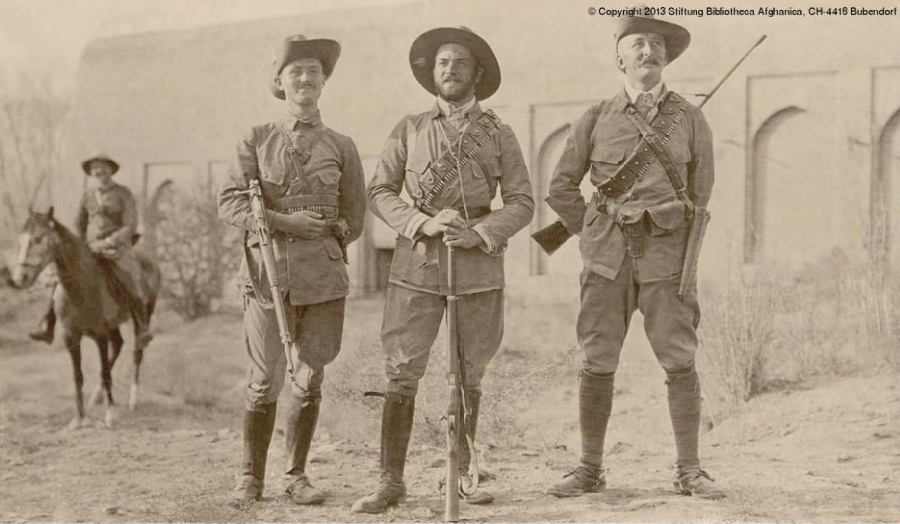
The German Military Leadership Outside Kabul 1915
This photograph shows three members of the German military mission.
From left to right they are Leutnant
Günther Voigt,
Oberleutnant Oskar Niedermayer and Kapitänleutnant d.R
Kurt Wagner. They all
wear the 1907 Landespolizei uniform with Südwester hats.
None shows an rank insignia. Note that Niedermayer does not have his hat pinned up on the side,
but that his hat still has the Imperial crown badge, now on the
underside of the brim. They are heavily
armed with rifles and pistols (Wagner having a shotgun or hunting rifle).
They all carry the Landespolizei ammunition bandolier (Voigt wearing
it around his waist). Two of them wear leather
gaiters while Wagner has puttees. Mounted in the background is
Leutnant von
Hentig, the expedition's diplomatic leader, also appearing to be
in dark khaki.
Photo
©
Stiftung Bibliotheca Afghanica
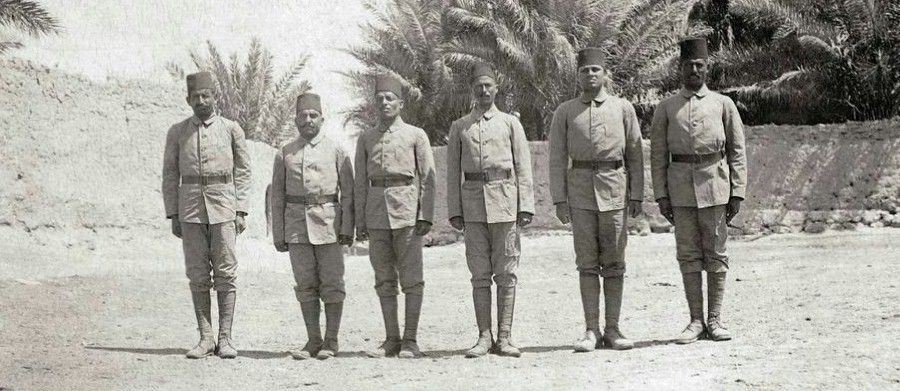
Pathan Volunteers, Mesopotamia 1915
These are the six of the Pathan former prisoners of war recruited as an armed
guard to protect the mission. From left to right they are Feldwebel Mirmast, Itbargul, Mohabad
Khan,
the cook Seyed Achmed and the two volunteers that had arrived from
America, Abdur Rahman Khan and Abdul Subhan Khan. They wear simple khaki
uniforms, without shoulder straps or rank insignia and with six
buttons down the front. Along with their red fezzes, they may well
be from East African Schutztruppe stocks. In von Hentig's memoirs he
mentions that he ordered khaki uniforms for the Pathans. These
uniforms look very like those worn by askaris of the East African
askaris and may either be from existing Schutztruppe stocks or newly
made in Germany to the same pattern as the askari uniforms. The
uniforms also look very like the Ottoman army khaki uniforms and
another possibility is that they were issued these while in Ottoman
territory.
Photo
©
Stiftung Bibliotheca Afghanica
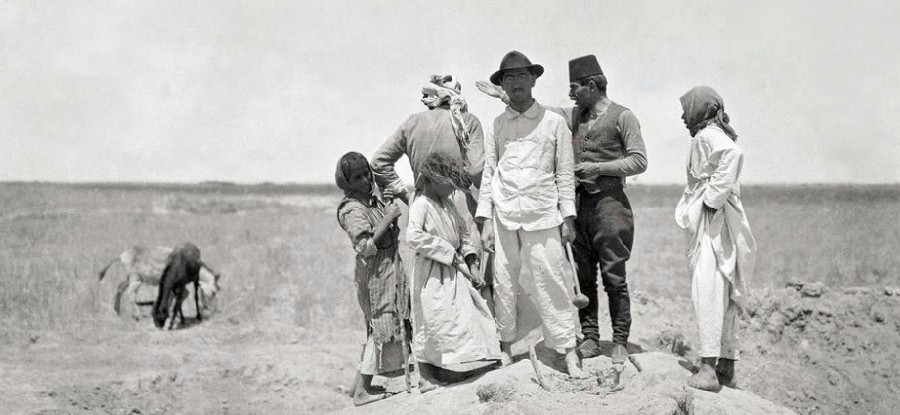
Incognito Through Mesopotamia 1915
The Afghan Mission travelled without military uniforms through
Mesopotamia and Persia so as to attract less attention. This
photograph shows Mahendra Pratap in a white outfit with civilian
hat, while the Ottoman officer Kâzım Orbay wears his red fez, a
civilian shirt and waistcoat with what looks like his Ottoman army
officers riding breeches.
Photo
©
Stiftung Bibliotheca Afghanica
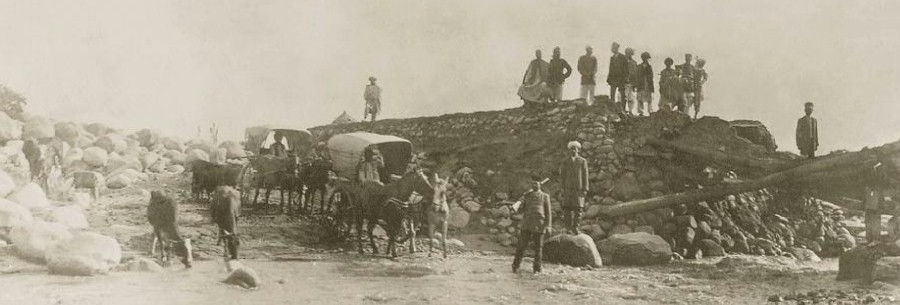
River Crossing in Mesopotamia 1915
Note the cows drinking, the mules pulling carriages and the guards
out of uniform but still armed, keeping a watch along the way.
Photo
©
Stiftung Bibliotheca Afghanica
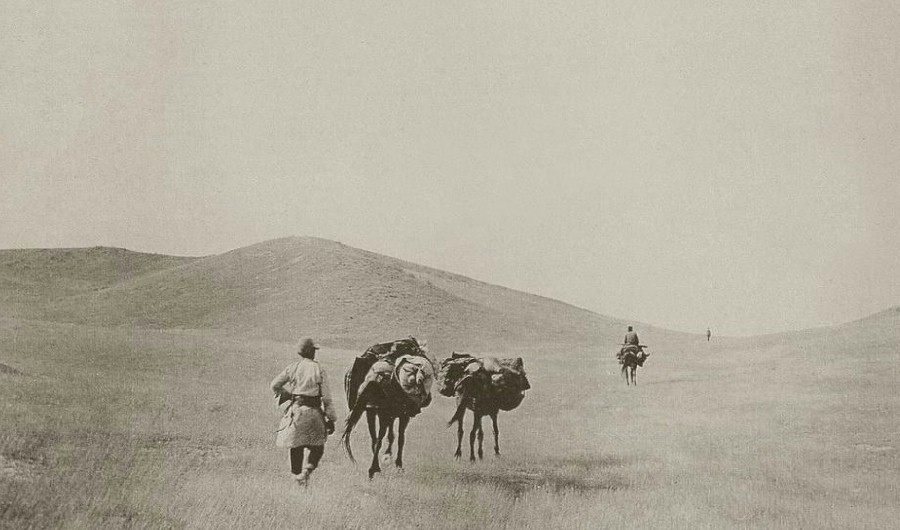
The Expedition in Eastern Persia,
July 1915
The mission continues on its long and hazardous trek towards Kabul.
Photo
©
Stiftung Bibliotheca Afghanica

German Officer with Pathan Volunteers in Uniform,
Afghanistan 1915
This photograph was taken shortly after the mission arrived in
Kabul. In the background the walls of the Gardens of Babur can be
seen. The photo show four of the Pathan volunteers with
Walter Röhr. Röhr wears the 1907 Landespolizei uniform
which the Germans put back on after crossing the Afghan border with what may be a locally acquired slouch hat. The Pathans no
longer wear their askari uniforms (which being thin cotton may have
worn out during the crossing of the Persian desert). Three of them
now appear to wear the Landespolizei uniform, while one wears a
paler khaki tunic. All have breast pockets so are certainly not the
same tunics as seen in the previous photo of the Pathans taken
months before in Mesopotamia. Some wear leather gaiters while others
have puttees with their ankle boots. They mostly carry the Landespolizei
bandoliers over their shoulders or around their waists.
Two are armed with what looks like Mauser Gew98 rifles, the other
two have pistols, the man in the front left with a Luger P08 with a
butt extension.
Photo
©
Stiftung Bibliotheca Afghanica
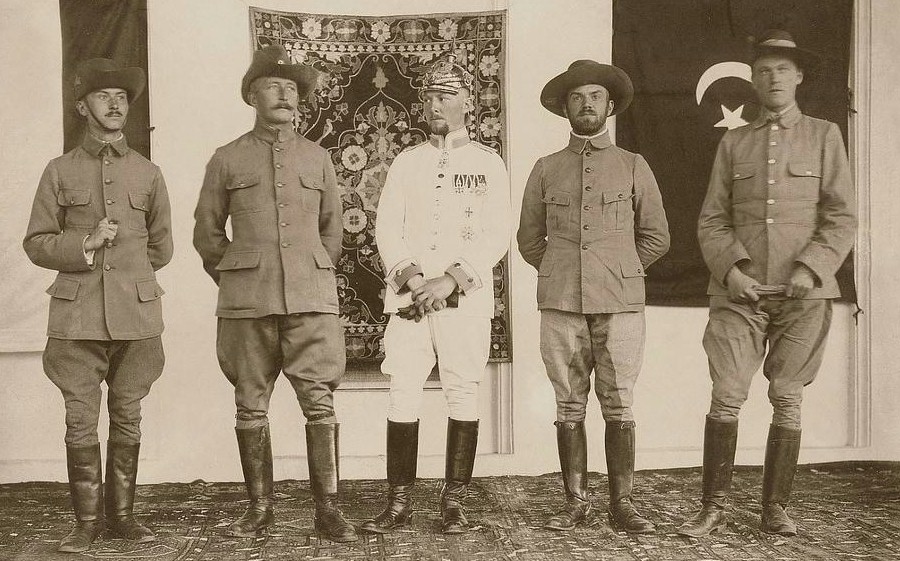
German Representatives of the Afghan Mission, Kabul 1915
From left to right they are Leutnant
Günther Voigt,
Kapitänleutnant d.R Kurt Wagner,
Leutnant Werner von Hentig, Oberleutnant Oskar Niedermayer
and Walter Röhr. Except for von Hentig, they all wear the 1907 Landespolizei
tunic, riding breeches and
Südwester hat. Note Voigt's yellow metal Imperial crown badge can
clearly be seen on the right side of his hat, while Wagner's cockade
can be seen at the front of his. Niedermayer's hat is not pinned up
at the side but his Imperial crown badge can still be seen attached
to the underside of the brim.
In the centre Leutnant von Hentig wears
his white uniform as an officer in the 3rd East Prussian Cuirassiers ("Kürassier-Regiment
'Graf Wrangel' (Ostpreußisches) Nr.3") which he kept packed and pristine throughout the
journey to Kabul. The uniform is white with regimental light blue
collar and cuffs. He wears several medals- the Persian Lion and Sun Commander's
Order at the throat and on the breast, a Prussian Iron Cross first class is also
on the breast. His medal bar consists of the Prussian Iron Cross second class,
Prussian Life Saving Medal (earned as a schoolboy in 1904), second award of the
life saving medal (awarded in 1907) with the cross of the General Honour Medal
and the Ottoman Medjidie Order. The Persian and Ottoman awards probably date
back to his pre-war service in the German
diplomatic corps in these countries. He wears the polished steel Cuirassier helmet with a yellow metal
spike and Prussian eagle of the 3rd Cuirassiers.
Recommended
External Links-
Kuerassier Regimenter and a discussion on
Von Hentig's Medals at the Pickelhaubes Forum
Photo
©
Stiftung Bibliotheca Afghanica
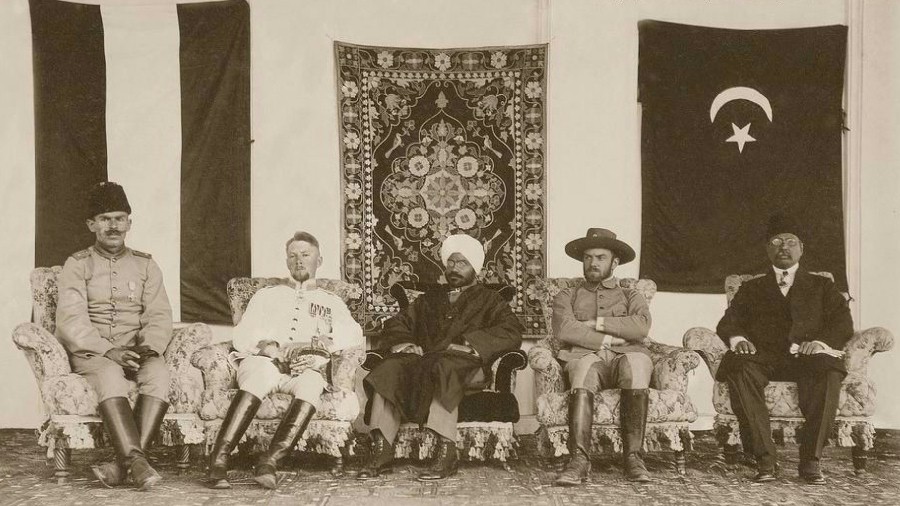
Leaders of the Afghan Mission in Kabul 1916
This photograph shows the
multi-national representatives of
the Afghan Mission. From left to right, they are the Ottoman Sultan's
representative
Kâzım Orbay,
Leutnant von Hentig,
the Hindu Indian Nationalist leader Mahendra Pratap, Oberleutnant Oskar
Niedermayer and the Islamic
Indian Nationalist Maulavi Barkatullah. The
tension between the group is clearly visible especially
in Niedermayer's body language.
In the background are the German and Ottoman flags.
On the left, Major Kâzım Orbay wears an olive green Ottoman
army officers uniform with the black lambs wool Kalpak hat. On his left breast
is the Prussian Order of the Crown, awarded to him by von Hentig.
Next to Orbay is Leutnant Werner von
Hentig wearing the uniform of an Officer of the Prussian Cuirassiers
as in the previous photograph. He has his spiked helmet on his lap.
In the centre is Mahendra Pratap, the leader of the
Indian nationalists. He wears a long Indian gown over a Western suit and a white
turban. Again, some of these may be items made for the expedition by Afghan
tailors. At his throat is the Prussian Order of the Red Eagle second class which
he had been awarded by Kaiser Wilhelm II.
Oberleutnant Oskar Niedermayer sits
to the side of Pratrap. He wears the 1907 Landespolizei uniform as
seen in the previous photograph.
Maulavi Barkatullah is
on the far right. He wears and suit and tie with a black lambs
wool hat. These may be items
have been carefully brought across the Persian desert or made for
the expedition by Afghan tailors upon their arrival. It may be a round or
diamond shaped medal at his throat (such as the non-Christian Prussian Order of
the Red
Eagle) or perhaps simply a pendant.
Photo
©
Stiftung Bibliotheca Afghanica
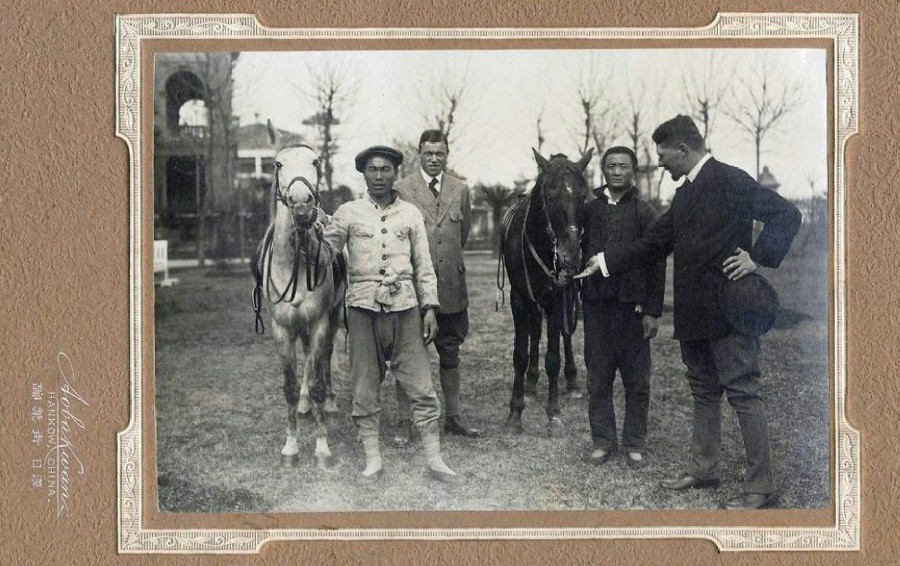
Von Hentig and Röhr in China
This photograph was taken in Hankow in China in late 1916 or early
1917 after their hazardous journey from Kabul through the Pamir
Mountains. It shows Röhr on the left and von Hentig on the right
wearing smart civilian clothing that they presumably purchased in
China. They are accompanied by two Chinese servants and their ponies.
Photo
©
Stiftung Bibliotheca Afghanica
| |
|
|
| |
Biographies of
Members of the Afghan Mission
German Leadership
Oskar Niedermayer
(1885-1948) joined the 10th Bavarian Artillery Regiment in 1905. After his
initial military service, he travelled India and Persia where he immersed himself
in studying the languages, geography and natural history of the regions. He
returned to Germany shortly before the outbreak of the First World War and
served in his original regiment on the Western Front. While their he
applied for an overseas mission. With his
experience of Asian culture he was deemed the ideal candidate to lead the military
aspect of the Afghan Mission of 1915-16. During the expedition he clashed
with the diplomatic leader von Hentig over policy issues.
However Niedermayer's determination and
caution got them to Kabul through the hazardous journey. After the failure of the
mission to entice the Emir of Afghanistan to wage war on British India
Niedermayer and Hentig made their separate ways back home.
Niedermayer took the route back through Persia and the Ottoman Empire. Upon
his return to Germany in 1918 he awarded the highest Bavarian
military award, the Military Order of Max Joseph along with the
title Ritter von Niedermayer for his efforts and went back to the
Western Front as
an Artillery officer (now promoted to Hauptmann). After the war he
served in the Freikorps Epp against communists in
Munich. In the 1930s he served as a military
attaché to the Soviet Union. During the Second World War he commanded a
Division of the "Ost-Legion" made up of Russian Asians but was arrested for defeatism in
1944 after making pessimistic comments about the War. Heinrich Himmler personally wrote in his
support at his trial. After the war he was arrested by
the Soviets and sentenced to 25 years imprisonment. He died of tuberculosis in
a Russian prison in 1948.
Werner Otto von Hentig, German Diplomatic Leader of the Expedition (1886-1984) was
a Leutnant in the
3rd East Prussian Cuirassiers ("Kürassier-Regiment
'Graf Wrangel' (Ostpreußisches) Nr.3")who had also studied law in Germany
and France and qualified a degree in international law from Bonn University. He
then served in the diplomatic corps in as a military attaché in Peking and
Constantinople and then as legation secretary in Tehran, where he learned
Persian. When the First World War broke out he served with his regiment on the
Eastern Front where he was wounded in the First Battle of the Mausurian Lakes.
In March 1915 he was recalled to Berlin to head the diplomatic
side of the Afghan Mission. He presented the Kaiser's letter to the Emir
personally but to no avail. After the failure of the mission he travelled
across the Pamir Mountains with a small group (including his Pathan cook Seyed
Achmed, Walther Röhr, the Hungarian/Rumanian Jossip Janosch, and a Persian Mule
attendant Afgher) to China. From there he boarded a ship to Hawaii where he gave
himself up to the as yet neutral American authorities. They repatriated him to
Germany where he was awarded the House Order of Hohenzollern by Kaiser Wilhelm
II in person. He was considered for the Pour-le-Mérite but it was not eventually
awarded. He remained in the diplomatic corps for the rest of his career serving
in Turkey, Poland, Bulgaria, Columbia and the United States of America. In the
1950s he was West German Ambassador to Indonesia.
Indian Nationalist Leaders
Raja (Kumar) Mahendra Pratap, Leader of the Indian Nationalists
(1886-1979) was born into an Indian Princely family in Uttar
Pradesh in Northern India. He was the
visionary founder of his own
religion, the Society of the Servants of the Powerless and their Great School of
Love to which he donated his palace and half his fortune.
He believed strongly in Indian Independence and the
rights of the common man. In 1907 he
travelled the world visiting London, Paris, Berlin, Tokyo and the United States
of America. When the First World War broke out he travelled to Berlin via
Switzerland for an audience with Kaiser Wilhelm II, who awarded him the Prussian
Order of the Red Eagle, second class and pledged support for Pratap's Mission to
Afghanistan. On the way to Kabul, he had meetings with the exiled Khedive of
Egypt in Vienna and Enver Pascha, the Ottoman Defence Minister who both also
gave their support to Pratap. In Kabul he met with the Emir who for unexplained
reasons did not like him. Nevertheless, with the Emir's support Pratap set up
the Indian Provisional Government in Kabul with himself as President. Eventually
the British put pressure on the Emir of Afghanistan to disband the provisional
government which he did. Pratap then went to Russia, where he met with Lenin and
later Tokyo where he spent the Second World War supporting the cause of Indian
Independence. He finally returned to India in 1946 and later was elected to the
Indian Parliament as an independent candidate.
Abdul Hafiz Mohamed
Barakatullah (1854-1927) also known as Maulavi or Maulana Barkatullah was
the second highest ranking Indian on the Afghan Mission and
the senior Muslim leader in the group. He was educated in Bhopal, Bombay and London where he also taught Arabic, Persian,
and Urdu. While teaching in Liverpool he became friends with Sirdar
Nasrullah Khan,
brother of the Emir of Afghanistan. He later taught in the United States, became
a Professor of Tokyo University and travelled to Russia,
Turkey and Egypt. He used his travels to promote the cause
of Indian Independence. When the First World War broke out
he was in America and soon travelled to Germany to become
one of the leaders of the Indian Committee in Berlin. He
served on the Afghan Mission and was appointed Prime
Minister of the Provisional Indian Government in Kabul.
After three years he returned to Germany where he published
the revolutionary magazine, Naya Islam. In 1921, along with
other Indian Nationalists he travelled to Moscow and after
his return in Germany remained in close contact with the
Soviet Government. In 1926 along with Pratap he travelled to
the United States of America again to promote Indian
nationalism. It was in San Francisco the following year when
he died. Although he wished to be reburied in India after
Independence his remains are still in Sacramento City
Cemetery, California. In 1988 Bhopal University was renamed
Barakatullah University in his honour.
Chempakaraman Pillai
(1891–1934)
was a Tamil from Southern India who had been partially educated in
Austria. On the Outbreak of the First World War he formed the
Pro-India Committee in Switzerland, but later merged with other
Indian nationalists in Germany into the Indian Independence
Committee. He took part in the Afghan Mission and the set up of the
Provisional Indian Government in exile. Himself taking the role of
Foreign Minister. After the
war he remained in Germany to further the cause of Indian
Nationalism. After falling foul of the Nazi regime
Pillai died in 1934, with some suspecting food
poisoning on Hitler's orders. His widow finally managed to
get his ashes back in a free India in 1966.
Ubaidullah Sindhi (1872-1944)
was a Sikh but converted to Islam. He was a noted nationalist leader
involved in the Pan-Islamic movement and the Deobandi Islamic
School. When the First World War broke out he was involved in the
Silk Letter Conspiracy to encourage foreign support for an Indian
Rebellion while Britain was busy fighting a war on the Western
Front. Sindhi's role in this was to travel from India to Kabul to
enlist the support of the Afghan Emir. He was already in Kabul when
the Niedermayer-Hentig Mission arrived. Along with the other Indian
nationalists he formed the Provisional Indian Government in exile,
in which he was the Home Minister. Another Deobandi leader,
Maulavi Bashir was the Minister for War. After the war Sindhi
travelled through Russia and Turkey before settling to spend
fourteen years studying Islam in Saudi Arabia.
Representative of the Ottoman
Sultan
Kâzım Orbay
(1887-1964) graduated from the
Ottoman
Imperial School of Military Engineering
and joined the Ottoman army in 1904 as an artillery lieutenant. In
1908 he trained in Germany before seeing action in the Balkan Wars. As one of
Enver Pascha's favourite officers he served as chief adjutant to the Ministry of
War before being selected to represent the Ottoman Empire on the Afghan Mission.
In Kabul he presented the Emir with a letter confirming the support of the
Ottoman Sultan if Afghanistan sided with the Central Powers. After the First
World War, Orbay served in the War of Turkish Independence in the Caucasus and
at the
Battle of Dumlupinar. In peacetime he married Enver Pascha's sister
and continued in Turkish military service, briefly returning to Afghanistan as
Chief of General Staff in 1928. Back in Turkey he was further promoted until his
retirement in 1946 by which time he was a four star general and Chief of General
Staff of the Turkish Army. In 1961 he was elected a Senator and served as a
President of the Turkish Parliament.
Other German Personnel on the
Mission
Walter Röhr (1892-1927) was von Hentig's
personal companion and the negotiator and
language expert
of the mission. Like many of the Germans in
the expedition, Röhr had previous experience of the Orient, in Röhr's case as a
merchant in Persia. Originally from Magdeburg, he had lived in Persia since he
was seventeen and spoke fluent Turkish and Persian. When war broke
out in 1914 he made his way back to Germany on a small boot through
the Persian Gulf to Ottoman Turkey and from there home. Along with the
expedition's doctor, Dr Becker, Röhr accompanied von Hentig from Germany to
Istanbul. After Niedermayer and Hentig went their separate ways from Kabul, Röhr
again accompanied von Hentig to China. He later married von Hentig's sister.
Dr. Karl Becker (___-1945)
of the Prussian Guards Jäger Battalion ("Garde-Jäger-Bataillon") was
the mission's doctor. He had already served two years in Persia
dealing with malaria and other tropical diseases and spoke good
Persian. On the way through Persia with the Afghan Mission he split
into a separate group with some of the sick and the camel section.
His group was spotted and surrounded by a Russian patrol. He fought
them off for several days until running out of ammunition. He then
buried the valuable equipment and gold that the camel section had
carried and made a break along with some of the sick Afridi
volunteers through Russian lines. All were shot down or captured but
Becker managed to escape with a lung wound. He was kindly trended
back to health under his own instruction by the locals that came
across him. Within two weeks he felt well enough to go back to look
for the equipment and gold that he had buried. It was then that he
was captured and sent to the Russian
Nargin
Island prisoner of war camp, where served as a doctor. After the
First World War he continued in civilian private practice settling
in Berlin where he was killed during the Russian Siege of the city
in 1945. Kapitänleutnant d.R
Kurt Albert Wagner was formerly a ships' officer of
the Hamburg-America Shipping Line ("Hamburg Amerikanische Paketfahrt
Actien-Gesellschaft" or HAPAG) operating in the Persian Gulf. He
served on the Afghan Mission to Kabul.
Leutnant
Günther Voigt
of the 4th Prussian Guards Field Artillery ("4. Garde-Feldartillerie-Regiment") was Niedermayer's adjutant
on the mission. He was one of the few on the Afghan Mission who had no previous experience of overseas service.
Hans Jakob of the Bavarian
Light Horse was Niedermayer's
Orderly and was
one of the men Oskar Niedermayer initially
requested for the mission. He accompanied Niedermayer throughout the
voyage to Afghanistan but died of fever just outside Kabul and was
buried there with full honours.
Fritz Niedermayer was Oskar's brother and a doctor. He too
was one of the men Oskar Niedermayer initially requested for the
mission.
Leutnant Walter Griesinger was an artillery officer on the
Afghan Mission who did not make it to Afghanistan but remained in
Southern Persia inciting their nationalists to rise up against the
British.
Professor Erich Zugmeyer was one of the
men Niedermayer initially requested for the mission. He was a
Bavarian zooologist who had recently travelled Baluchistan.
He did not make it to Afghanistan but remained with
Griesinger
in Southern Persia
inciting rebellion against the British.
Fritz Seiler
was another member of the mission who
did not make it to Afghanistan but remained in Southern Persia
with
Griesinger and Zugmeyer
inciting rebellion against the British.
An Eduard Seiler (a German Dragoman) on the Afghan Mission is referred to in "The Berlin-Bagdad
Express" it is not sure if this is the same person.
Hermann Consten,
the Mongolian Explorer was also recruited for Niedermayer's staff on
the Afghan Mission. He spoke several languages including Russian,
French, English, Swahili and Mongolian.
Wilhelm Paschen from German South West Africa
was a soldier on the expedition. A Peter Paschen is referred to
as being on the Afghan Mission in "The Berlin-Bagdad Express" it is
not sure if this is the same person.
Feldwebel
Beierl was awarded the Prussian Red Eagle
Medal by von Hentig for his service on the Afghan Mission.
Pathan Volunteers
Of the
eight Pathan volunteers, six are known to have been
Feldwebel Mirmast, Itbargul, Mohabad
Khan,
the cook Seyed Achmed and the two volunteers that had arrived from
America, Abdur Rahman Khan and Abdul Subhan Khan. Little is known
about their lives, although von Hentig gives us a glimpse
into Seyed Achmed in his memoirs-
Seyed Achmed
was the last of the six Afridi Pathans to be
recruited from the Halmondlager POW camp for the Afghan Mission. He
served as cook and servant to von Hentig. He and von Hentig struck
up a friendship on the expedition and afterwards when they both
travelled to China through the Pamir Mountains. Von Hentig mentions
in his memoirs that this man was the only Afridi on the mission that
had not deserted the British army but had been legitimately
captured. Von Hentig clearly respected him for that. Whereas the
other Pathans were happy to be released from German service with
their freedom in Kabul, Seyed wanted to return to his home in the
Buner Valley within British territory. Through Swedish and English
Missionaries, von Hentig successfully negotiated for the safe
conduct of his cook and companion with the British envoy to China
Sir John Jordan
Feldwebel Jemadar Mirmast
of the Pathan volunteers was awarded the Prussian Crown Medal
by von Hentig during the mission.
Austro-Hungarian
former Prisoners of War
Of the Austro-Hungarian
former Prisoners of War only two have so far been identified
by name.
Josef Janosch was a
Rumanian national of the Hungarian Honved accompanied von Hentig out of Afghanistan across the
Pamir Mountains into China.
Emil Rybitschka was an
Austrian Border-Gendarmerie Officer who wrote his memoirs as "Im
gottgegebenen Afghanistan als Gäste des Emirs" (Leipzig, Brockhaus
1927). |
|
| |
|
|
Sources
Recommended Reading -
"Like Hidden Fire" by Peter Hopkirk
"Geheime Expedition ins Ungewisse" by Eleonore Wöhrle, an article in
Kaskett Nr17 (Zeitschrift der Freunde des Bayerischen
Armeemuseums)
"War by Revolution: Germany and Great Britain in the Middle East
in the Era of World War I" by Donald M.
McKale
"Berlin-Bagdad Express" by Sean McMeekin
"The
German Mission to Afghanistan 1915-1916" by TL Hughes in In: German Studies
Review No25 (2002)
"Berlin, Kabul, Moskau -
Oskar Ritter von Niedermayer und Deutschlands Geopolitik" by
Hans-Ulrich Seidt
Several members
of the mission wrote their own memoirs of the mission. These are now
out of print and hard to find. I have used them as secondary sources
through other links-
"Unter der Glutsonne Irans: Kriegserlebnisse der deutschen
Expedition nach Persien und Afghanistan" by Oskar von Niedermayer (Dachau 1925)
"Meine Diplomatenfahrt ins verschlossene Land" by Werner
von Hentig (Berlin 1918)
"Von Kabul nach Shanghai"
by Werner von
Hentig (2002)
"My German Mission to High Asia" by Mahendra Pratap in Asia Magazine
No25 (1925)
"Morgenländische Rhapsodie" by Günther Voigt unpublished manuscript
(c1942)
Recommended External Links -
Hentig's Photo album and Information on
Phototheca-Afghanica
(highly recommended)
Biographical Information at
Phototheca-Afghanica
The
Niedermayer-Hentig Expedition at Wikipedia
Reisen in Zeiten der Not und Gefahr
by
Norbert Lüdtke on DZG
Photographs at the
Axis History Forum
Discussion on the
Pickelhaubes Forum
Discussion on the Wehrmacht Awards Forum
Article on the Niedermayer-Hentig Expedition
Bavibonc Blogspot on the Niedermayer-Hentig Expedition
From Palestine
to the Caucasus
Raja Mahendra
Pratap.net
Buddhist Art News
article on Hermann Consten
Thanks to Greg Gerardi, Glenn Jewison, Paul Bucherer-Dietschi of the Stiftung Bibliotheca Afghanica and the
friendly staff at the
Bavarian Army Museum for their generous help
on this page.
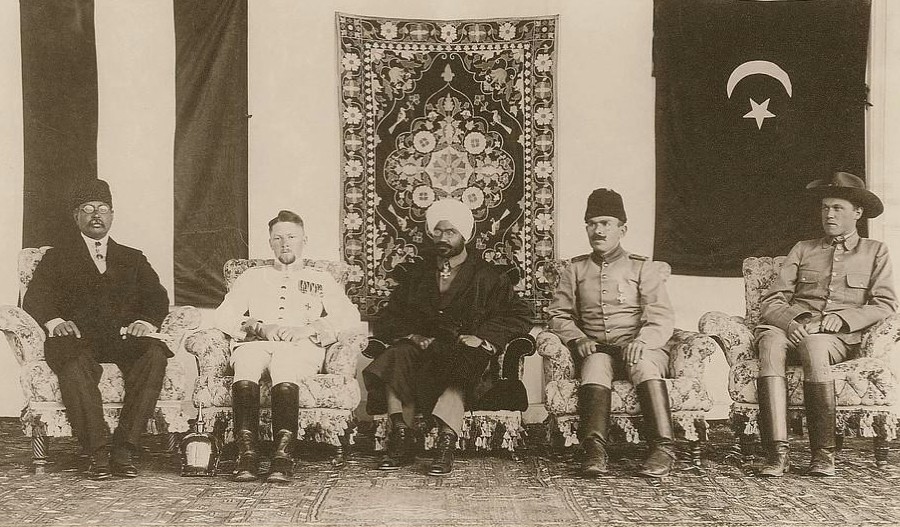
The Afghan Mission in Kabul 1915/16
From left to right the photograph shows-
Maulavi Barkatullah, Werner von
Hentig, Mahendra Pratap,
Kâzım Orbay and Walter Röhr
Photo
©
Stiftung Bibliotheca Afghanica
|
|